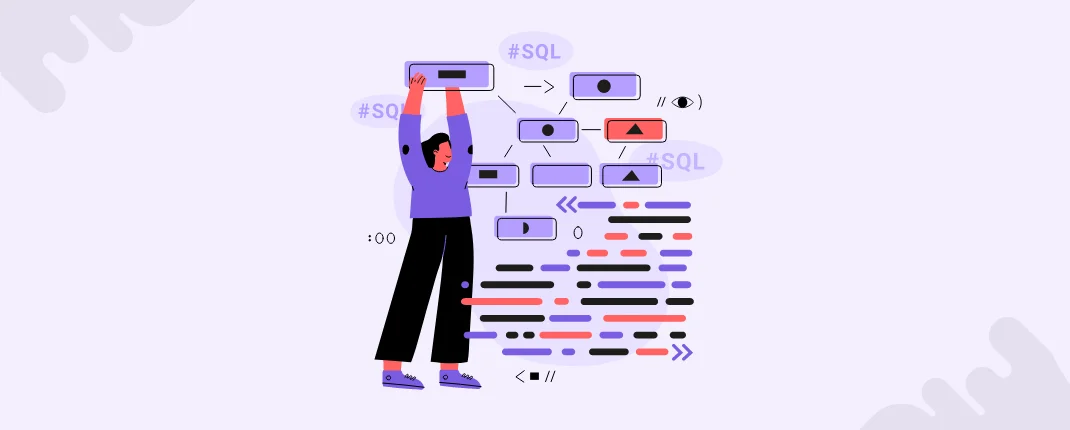
Muskan Tanneja
6 min read
Nowadays, Web development has surged to the forefront of technological innovation, shaping the way we interact, transact, and consume information online. In this dynamic field, choosing the right technology stack can make all the difference in creating robust and efficient applications. One such powerful stack that has gained immense popularity in recent years is the MEAN stack. Comprising MongoDB, Express.js, Angular, and Node.js, this combination of technologies offers a seamless and efficient framework for building dynamic web applications.
In this blog post, we will discuss how MEAN stack is beneficial for web development projects.
So, let’s dive in and start with the basics.
What Is MEAN Stack Development?

MEAN stack development refers to a particular combination of technologies used in web development. The acronym "MEAN" stands for:
-
MongoDB
A NoSQL database that uses a document-oriented data model. It stores data in flexible, JSON-like BSON (Binary JSON) format, which allows for easy retrieval and manipulation of data.
-
Express.js
A web application framework for Node.js. It simplifies the process of building robust and scalable web applications by providing a set of features and tools for handling routing, middleware, and more.
-
Angular
A front-end JavaScript framework developed by Google. It allows developers to build dynamic, single-page web applications with a rich user interface.
-
Node.js
A JavaScript runtime environment that allows developers to execute JavaScript code on the server side. It provides an event-driven, non-blocking I/O model that makes it efficient for building scalable and real-time web applications.
When combined, these technologies form a full-stack JavaScript framework that allows developers to build end-to-end web applications entirely in JavaScript. This means that developers can use JavaScript for both client-side (Angular) and server-side (Node.js) development, as well as for data storage (MongoDB).
The MEAN stack is known for its flexibility, scalability, and efficiency, making it a popular choice for building modern web applications and dynamic websites. Additionally, since all components of the MEAN stack use JavaScript, it offers the advantage of a unified language across the entire development process. This can streamline development workflows and make it easier for developers to work on different parts of the project.
Advantages Of MEAN Stack For Web Development Project

Using the MEAN stack for web development offers several advantages:
-
Single Language Throughout
With MEAN, you can use JavaScript for both the front-end (Angular) and back-end (Node.js) development, as well as for data manipulation in MongoDB. This eliminates the need to switch between different languages, making development more streamlined.
-
Code Reusability
Since JavaScript is used across the entire stack, you can reuse code between the client and server. For instance, you can share validation logic, data models, and even some business logic.
-
JSON for Data Exchange
JSON (JavaScript Object Notation) is used for data exchange between the client and server, as well as for storing data in MongoDB. This seamless integration of JSON simplifies data handling and reduces the need for data transformation.
-
Scalability
MEAN stack applications can be easily scaled both horizontally (adding more servers) and vertically (upgrading server resources). Node.js, in particular, is known for its ability to handle a large number of concurrent connections, making it suitable for real-time applications.
-
Speed and Efficiency
Node.js utilizes an event-driven, non-blocking I/O model, which allows for high concurrency and efficiency. This can result in faster response times and improved performance compared to traditional server-side technologies.
-
Rich Ecosystem
The MEAN stack has a large and active open-source community. This means there are plenty of libraries, modules, and resources available to help speed up development and address specific needs.
-
Support for Real-time Applications
Node.js, being event-driven and asynchronous, is well-suited for building real-time applications like chat applications, gaming platforms, and collaboration tools.
-
Flexibility and Adaptability
The MEAN stack allows for flexibility in terms of architecture. You can use the stack to build anything from single-page applications (SPAs) to more complex, multi-page web applications.
-
Ease of Testing
The MEAN stack has a range of testing frameworks and tools available for both front-end and back-end development. This facilitates comprehensive testing, ensuring robust and reliable applications.
-
Cross-Platform Compatibility
MEAN applications can be deployed on a wide range of operating systems, including Windows, macOS, and various Linux distributions. This ensures compatibility across different environments.
-
Cost-Effectiveness
Since MEAN uses open-source technologies, there are no licensing costs associated with using these tools. This can result in cost savings for businesses and startups.
-
Support for Microservices Architecture
The MEAN stack is well-suited for building applications using a microservices architecture, which allows for modular and independently deployable components.
Overall, the MEAN stack provides a powerful and efficient framework for building modern web applications, and its advantages make it a popular choice among developers and businesses alike.
Also Read: Latest Web Development Trends To Look In 2023
What Kind Of Web Apps Can Be Developed Using The MEAN Stack?
The MEAN stack is versatile and can be used to develop a wide range of web applications. Here are some examples of the types of web apps that can be developed using the MEAN stack:
-
Single Page Applications
MEAN is well-suited for building SPAs, where the entire application is loaded on a single page, and content is dynamically updated as the user interacts with the app.
-
E-commerce Platforms
MEAN can be used to create online shopping platforms with features like product listings, shopping carts, user authentication, and payment processing.
-
Social Networking Sites
Developers can build social networking platforms with user profiles, friend requests, messaging systems, activity feeds, and other social features.
-
Task Management and Productivity Apps
MEAN can be used to create apps for task management, to-do lists, calendars, and other productivity tools.
-
Blogging Platforms
MEAN stack can power platforms for creating and publishing blogs, including features for user authentication, content management, and social sharing.
-
Customer Relationship Management Systems
MEAN can be used to develop CRM systems for managing customer interactions, leads, sales, and support.
-
Online Forums and Communities
MEAN stack can be used to build discussion forums and online community platforms with features like user authentication, threaded discussions, and user-generated content.
-
Educational Platforms
MEAN can be used to create e-learning platforms, online course management systems, and interactive educational tools.
-
Booking and Reservation Systems
MEAN can be used for applications that facilitate booking appointments, reservations, tickets, or accommodations.
-
News and Media Platforms
MEAN can be used to build platforms for delivering news articles, videos, images, and other media content.
-
Analytics Dashboards
MEAN can be employed to create data visualization and analytics dashboards for tracking and analyzing various metrics.
-
IoT Dashboards and Control Panels
MEAN stack can be used to build web interfaces for controlling and monitoring IoT devices and systems.
These are just a few examples, and the versatility of the MEAN stack allows for the development of many other types of web applications. The choice of application will depend on the specific requirements and objectives of the project.
Popular Apps Built With MEAN Stack

-
LinkedIn
LinkedIn, the professional networking platform, reportedly used the MEAN stack in some parts of its development.
-
PayPal
PayPal, a widely used online payment platform, utilized the MEAN stack for parts of its development.
-
Netflix
Netflix, While not the entire platform, certain components of Netflix were known to have been developed using the MEAN stack.
-
Uber
LinkedIn, Uber, the ride-hailing service, has used MEAN for parts of their infrastructure.
-
eBay
eBay, one of the world's largest online marketplaces, is known to have used the MEAN stack for certain projects.
-
Walmart
Walmart, a global retail giant, has used the MEAN stack for certain projects and applications.
-
Medium
Medium, the popular online publishing platform, was known to have used the MEAN stack for some of its components.

Conclusion
In conclusion, the MEAN stack stands as a testament to the power of synergy in web development. MongoDB provides a flexible and scalable database solution, while Express.js streamlines the server-side operations. Angular's robust front-end capabilities enable dynamic user interfaces, and Node.js ensures seamless communication between server and client. Together, they form a cohesive unit that empowers developers to craft modern, feature-rich web applications.
So, whether you're building a personal project or working on a large-scale enterprise application, consider harnessing the power of the MEAN stack. Its versatility, efficiency, and scalability make it a compelling choice for a wide range of web development projects. Embrace the MEAN stack, and unlock a world of possibilities in web development!

